Exploiting cross-platform development frameworks to deliver insidious malware. A recent report from McAfee highlights the emergence of Android malware campaigns that are leveraging the .NET MAUI framework to evade detection and steal sensitive user information. This marks a significant shift in tactics, requiring security professionals and users alike to stay vigilant.
The rise of .NET MAUI malware
.NET MAUI (Multi-platform App UI) is a cross-platform framework developed by Microsoft that allows developers to create applications that can run on multiple operating systems, including Android and iOS, from a single codebase. While this offers numerous benefits for legitimate developers, it also presents an attractive opportunity for malicious actors.
These cybercriminals are disguising their malware as legitimate-looking applications, often mimicking popular services or utilities. The primary distribution method appears to be through unofficial app stores and, alarmingly, via phishing links. This means users who download apps from untrusted sources are at a significantly higher risk of infection.
Targeting users in India and China
The McAfee report indicates that recent campaigns have specifically targeted users in India and China. The attackers employ various techniques to pilfer sensitive data, including:
- Data Theft: Stealing personal information, login credentials, financial data, and other valuable user data.
- SMS Harvesting: Intercepting and exfiltrating SMS messages, potentially gaining access to two-factor authentication codes and other sensitive information.
- Contact List Extraction: Harvesting contact lists for further phishing and social engineering attacks.
Technical deception: hiding in plain sight
What makes this new wave of malware particularly dangerous is its ability to evade detection. The attackers are employing several sophisticated techniques to achieve this:
- Blob Binary Obfuscation: The malware hides its core malicious code within blob binaries, making it difficult for traditional antivirus solutions to identify and analyze the threat. This leverages MITRE ATT&CK Technique T1140 (Deobfuscate/Decode Files or Information).
- Multi-Stage Dynamic Loading: The malware uses a multi-stage loading process, dynamically loading components and functionalities only when needed. This further obscures its true purpose and makes static analysis extremely challenging.
- Scripting and Encrypted Communication: C# scripts, hidden within the app, are used to collect and transmit user data (MITRE ATT&CK Technique T1064 (Scripting)). This data is then transmitted using TCP socket communication (MITRE ATT&CK Technique T1071 (Application Layer Protocol)) and encrypted using standard cryptographic protocols (MITRE ATT&CK Technique T1032 (Standard Cryptographic Protocol)) to protect it from interception.
- Manifest Manipulation: The malware manipulates the AndroidManifest.xml file, adding unnecessary permissions to disrupt automated scanning processes (MITRE ATT&CK Technique T1070 (Indicator Removal on Host)).
Indicators of Compromise (IOCs)
Security researchers have identified several indicators of compromise associated with these campaigns:
- IP Address: 120.27.233.135
- URL:
https://onlinedeskapi.com
These IOCs can be used to identify potentially infected systems and block communication with malicious servers.
Staying protected: a multi-layered approach
So, what can you do to protect yourself and your organization from this evolving threat? Here are some key recommendations:
- Stick to official App Stores: only download applications from trusted sources like the Google Play Store. Even then, carefully review app permissions and developer information.
- Be wary of phishing: be extremely cautious of suspicious links and attachments, especially those delivered via email or SMS.
- Install a reputable Mobile Security Solution: a robust mobile security solution, like McAfee Mobile Security (which reportedly detects these threats as Android/FakeApp), can provide real-time protection against malware and other mobile threats.
- Keep your Software Updated: regularly update your operating system and applications to patch security vulnerabilities.
- Educate yourself and others: stay informed about the latest threats and security best practices. Share this knowledge with your family, friends, and colleagues.
The emergence of .NET MAUI-based Android malware represents a significant challenge for the cybersecurity community. By understanding the techniques used by these attackers and implementing proactive security measures, we can mitigate the risk and stay one step ahead of the evolving threat landscape. Don’t let your guard down – vigilance is key!
